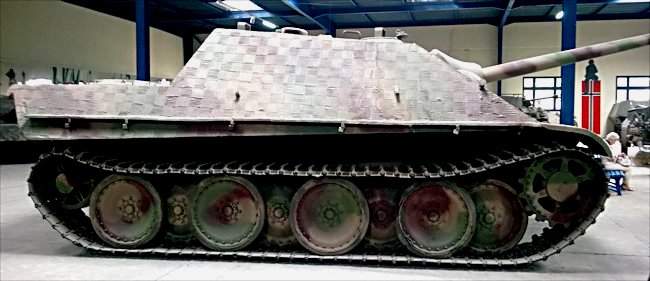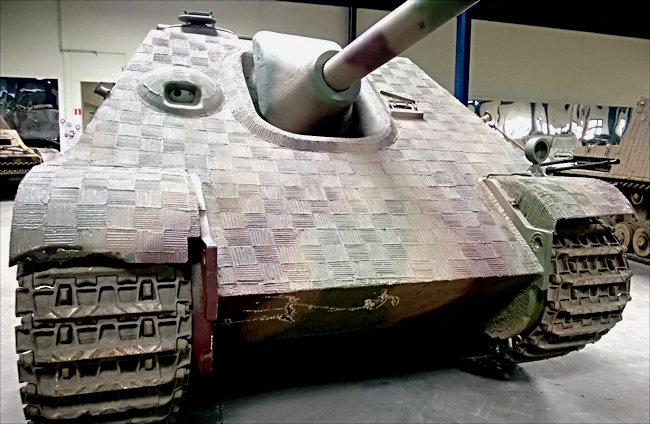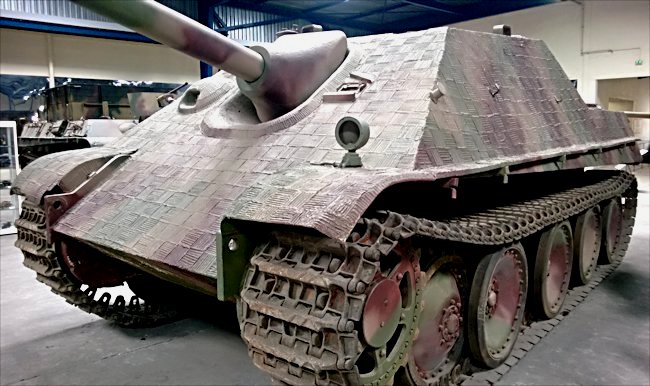The Jagdpanther Tank Destroyer
This German WW2 Jagdpanther Tank Destroyer can be found at the French Tank Museum in Saumur in the Loire Valley. The Museum is called Musée des Blindés ou Association des Amis du Musée des Blindés, 1043, route de Fontevraud, 49400 Saumur, France www.museedesblindes.fr . The word Blindés means armoured.

German WW2 88mm paK 40 Jagdpanther Tank Destroyer at the French Tank Museum in Saumur
Why was the German 88mm Jagdpanther so hard to kill?
The Jagdpanther was one of the most formidable tank destroyers of World War Two. The Germans had learnt to their cost of the effectiveness of the T 34 tank's sloping armour and wide tank tracks. They incorporated these design features into this new tank destroyer. The sloping armour made it increasingly hard to destroy from a frontal attack. The wide tracks enable it to cross muddy fields with ease.
It was based on the Panzer V Panther tank chassis. It was an amazing ambush weapon. German tank destroyers were developed because of the urgent need to tackle the threat from the Russian KV-1 heavy tanks and the T34/76 medium tanks deployed in mass waves of armoured power by the Red Army. The superiority of the Russian armoured vehicles was a big shock to the German high command.

No Allied tank main gun's shell could penetrate the sloping frontal armour of the German WW2 Jagdpanther Tank Destroyer
German artillery units had the gun that could tackle anything that the Russian army sent towards the position. It was the Pak 40 field gun. It was an evolution of the very effective 88 mm Flak 36 field gun that had devastated Allied armoured vehicles in France and the deserts of North Africa.
Whilst it was the same caliber, it was an altogether different gun. It used a longer and heavier shell. Hitler had wanted it fitted to the Panzer V Tiger I tank. The problem was that the turret was simply not large enough. It would eventually be fitted to the King Tiger main battle tank that was use in the Battle of the Bulge and on the Eastern front. This very effective gun was fitted to the Nashorn and Ferdinand self-propelled guns, but both suffered from poor armour protection.

The wide tank tracks were copied from the Russian T34 tank. It enabled this heavy German WW2 Jagdpanther Tank Destroyer to cross muddy and boggy open ground easier.
The Jagdpanther's 88 mm gun could only traversed 22° although this does not sound much compared with a normal tank's 360° traverse remember that 22° lateral traverse means that it can cover an area of 600 m wide a range of 1,500m without having to reposition the tank. At 1000 m range. It could still cover an arc 400 m. This meant that a platoon of three or four Jagdpanther tank destroyers could cover a wide area of the battlefront at long ranges. They could engage a light tanks before they could fireback.
The Jagdpanther's 88 mm gun could fire high explosive shells against infantry and soft sided vehicles. The main shell is fired was armour piercing. The gunner had the choice of loading to different armour piercing shells. The first was the Panzersprenggranate 39/43 with a small bursting charge and the Panzergranate 40/43 with a solid tungsten core. The last one was rarely used as tungsten was in short supply and urgently needed elsewhere.
The 39/43 shell weighed over 23 kg. It's velocity was 1000 m/s, which meant it could penetrate 150 mm of sloped armour at 1,500m range. In real terms, this meant that the Jagdpanther tank destroyer's armour piercing shell could penetrate the front armour of all the Allied tanks. The one exception was very 160 mm armour on the front of the turret of the Russian IS-2 tank. Although heavier than the Panther tank, the Jagdpanther matched the road and cross-country speed of the Panther tank. It had a maximum speed of 55 km/h on the road and 46 km/h cross-country.
The death of Jagdpanther 134 in Belgium 1944
Although three, Schwere Panzerjager-Abteilung, tank destroyer battalions took part in the Battle of the Bulge in 1944 the Jagdpanther tank destroyer was rather a rare beast. These units only had one company actually equipped with this formidable machine.
Most Allied guns could not penetrate the front sloping armour of a Jagdpanther. The shells just bounced off. So long as the panzer crew kept the front of the armour pointing towards the enemy they were comparatively safe.
The Jagdpanther was designed to kill at a distance. It’s 88mm long barrelled high velocity gun to knock out all allied tanks over two kilometres away. The crews were trained to find a defensive position in a location where they expected the Allied tanks to appear. The main tactic was to pick off enemy tanks at long range so they were unable to fire back and hit them. When the enemy got too close they would retire to a second defensive position and start again.
This type of tactic did not always work. Jagdpanther number 134 of schwere Panzerjager Abteilung 654 was knocked out. The crew reversed their vehicle into a wood with the view of setting up an ambush. Unfortunately they did not know that they had already been out flanked. Sherman tanks were already behind them and were able to fire at its weak rear armour.
What is Zimmerit?
Zimmerit was an anti-magnetic mine measure, As the Germans had designed the Hafthohlladung magnetic mine they expected that the Allies in particular the Soviets to follow suit. That neither the Soviets nor the Western allies aped the Germans in this respect says something about the veracity of German weapon design. Zimmerit is actually fire proof - having a base of Actinolite - brown Asbestos waste and also has a high white lead content, which no doubt aided drying times. One negative point on the use of Zimmerit for the German tank crews was that the British found it helped to prevent PIAT grenades pinging off when they hit at an angle.
Where can I find other preserved Jagdpanthers?
- Bovington Tank Museum England
- Imperial War Museum Duxford, London England
- Weald Foundation England (running condition)
- Munster Panzer Museum Germany (running condition)
- Wehrtechnische Dienststelle Trier, Germany (running condition)
- Auto + Technik Museum, Sinsheim Germany
- Thun Tank Museum Switzerland
- Saumur Tank Museum France
- Kubinka Tank Museum Russia
- U.S. Army Center for Military History Storage Facility, Anniston, AL, USA
- Source - Pierre-Oliver Buan - http://the.shadock.free.fr/Surviving_Panzers.html
WW2 tank books

